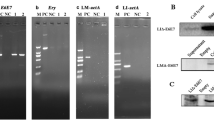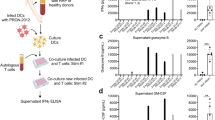Abstract
Infection of genital epithelial cells with human papillomavirus (HPV) types 16 and 18 is closely associated with the development of cervical carcinoma. The transforming potential of these high-risk HPVs depends on the expression of the E6 and E7 early viral gene products. Since the expression of E6 and E7 is selectively maintained in premalignant and malignant cervical lesions these proteins are attractive candidates for immunotherapeutic and prophylactic strategies. This report describes the construction, characterization and the in vivo immunotherapeutic potential of recombinant Semliki Forest virus (SFV) expressing the HPV16 E6 and E7 proteins (SFV-E6E7). Western blot analysis and immunofluorescence staining demonstrated expression of E6 and E7 in BHK cells infected with SFV-E6E7. Immunization of mice with SFV-E6E7 resulted in an efficient in vivo priming of HPV-specific CTL activity. The induced CTL lysed murine tumor cells transformed with the HPV16 genome and EL4 cells loaded with an immunodominant class I-binding HPV E7 peptide. CTLs could reproducably be induced by immunization with three injections of as few as 105 infectious units of SFV-E6E7. Protection from tumor challenge was studied using the tumor cell line TC-1. Immunization with 5 × 106 SFV-E6E7 particles protected 40% of the mice from tumor challenge. These results indicate that E6E7 expression by the efficient and safe recombinant SFV system represents a promising strategy for immunotherapy or immunoprophylaxis of cervical carcinoma.
This is a preview of subscription content, access via your institution
Access options
Subscribe to this journal
Receive 12 print issues and online access
$259.00 per year
only $21.58 per issue
Buy this article
- Purchase on Springer Link
- Instant access to full article PDF
Prices may be subject to local taxes which are calculated during checkout








Similar content being viewed by others
References
Zur Hausen H . Viruses in human cancer Science 1991 254: 1167–1173
Münger K, Scheffner M, Huibregtse JM, Howley PM . Interactions of HPV E6 and E7 with tumor suppressor gene products Cancer Surv 1992 12: 197–217
Werness BA, Levine AJ, Howley PM . Association of human papillomavirus types 16 and 18 E6 proteins with p53 Science 1990 248: 76–79
Pei XF . The human papillomavirus E6/E7 genes induce discordant changes in the expression of cell growth regulatory proteins Carcinogenesis 1996 17: 1395–1401
Jones DL, Münger K . Interactions of human papillomavirus E7 protein with cell cycle regulators Semin Cancer Biol 1996 7: 327–337
Gulliver GA, Herber RL, Liem A, Lambert PF . Both conserved region 1 (CR1) and CR2 of the human papillomavirus type 16 E7 oncogene are required for induction of epidermal hyperplasia and tumor formation in transgenic mice J Virol 1997 71: 5905–5914
Porreco R et al. Gynecological malignancies in immunosuppressed organ homograft recipients Obstet Gynecol 1975 45: 359–364
Johnson JC et al. High frequency of latent and clinical human papillomavirus cervical infections in immunocomprised human immunodeficiency virus-infected women Obstet Gynecol 1992 79: 321–327
Feltkamp MC et al. Vaccination with cytotoxic T lymphocyte epitope containing peptide protects against a tumor induced by human papillomavirus type 16-transformed cells Eur J Immunol 1993 23: 2242–2249
Feltkamp MC et al. Cytotoxic T lymphocytes raised against a subdominant epitope offered as a synthetic peptide eradicate human papillomavirus type 16-induced tumors Eur J Immunol 1995 25: 2638–2642
Jochmus I et al. Specificity of human cytotoxic T lymphocytes induced by a human papillomavirus type 16 E7-derived peptide J Gen Virol 1997 78: 1689–1695
De Bruijn ML et al. Immunization with human papillomavirus type 16 (HPV16) oncoprotein-loaded dendritic cells as well as prrotein in adjuvant induces MHC class I-restricted protection to HPV16-induced tumor cells Cancer Res 1998 58: 724–731
Strauss JH, Strauss EG . The alphaviruses: gene expression, replication, and evolution Microbiol Rev 1994 58: 491–562
Liljeström P, Lusa S, Huylebroeck D, Garoff H . In vitro mutagenesis of a full-length cDNA clone of Semliki Forest virus: the small 6,000-molecular-weight membrane protein modulates virus release J Virol 1991 65: 4107–4113
Liljeström P, Garoff H . A new generation of animal cell expression vectors based on the Semliki Forest virus replicon Biotechnology (N Y) 1991 9: 1356–1361
Berglund P et al. Semliki Forest virus expression system: production of conditionally infectious recombinant particles Biotechnology (N Y) 1993 11: 916–920
Sedman SA et al. The full-length E6 protein of human papillomavirus type 16 has transforming and trans-activating activities and cooperates with E7 to immortalize keratinocytes in culture J Virol 1991 65: 4860–4866
Greenfield I, Nickerson J, Penman S, Stanley M . Human papillomavirus 16 E7 protein is associated with the nuclear matrix Proc Natl Acad Sci USA 1991 88: 11217–11221
Nindl I et al. The E7 protein of human papillomavirus (HPV) type 16 expressed by recombinant vaccinia virus can be used for detection of antibodies in sera from cervical cancer patients J Virol Meth 1996 62: 81–85
Braspenning J et al. A general purification protocol for E7 proteins from ‘high- and low-risk’ human papillomavirus types expressed in the yeast Schizosaccharomyces pombe Protein Expr Purif 1997 10: 192–201
Grossman SR, Mora R, Laimins LA . Intracellular localization and DNA-binding properties of human papillomavirus type 18 E6 protein expressed with a baculovirus vector J Virol 1989 63: 366–374
Daniels PR, Sanders CM, Maitland NY . Characterization of the interactions of human papillomavirus type 16 E6 with p53 and E6-associated protein in insect and human cells J Gen Virol 1998 79: 489–499
Toes REM et al. Peptide vaccination can lead to enhanced tumor growth through specific T-cell tolerance induction Proc Natl Acad Sci USA 1996 93: 7855–7860
Boursnell MEG et al. Construction and characterization of a recombinant vaccinia expressing human papillomavirus proteins for immunotherapy of cervical cancer Vaccine 1996 14: 1485–1494
Lin KY et al. Treatment of established tumors with a novel vaccine that enhances major histocompatibility class II presentation of tumor antigen Cancer Res 1996 56: 21–26
Chen L et al. Induction of cytotoxic T lymphocytes specific for a syngeneic tumor expressing the E6 oncoprotein of human papillomavirus type 16 J Immunol 1992 148: 2617–2621
Borysiewicz LK et al. A recombinant vaccinia virus encoding human papillomavirus types 16 and 18, E6 and E7 proteins as immunotherapy for cervical cancer Lancet 1996 347: 1523–1527
Glasgow GM, McGee MM, Sheahan BJ, Atkins GJ . Death mechanisms in cultured cells infected by Semliki Forest virus J Gen Virol 1997 78: 1559–1563
Berglund P, Fleeton MN, Smerdou C, Liljeström P . Immunization with recombinant Semliki Forest virus induces protection against influenza challenge in mice Vaccine 1999 17: 497–507
Rock KL . A new foreign policy: MHC class I molecules monitor the outside world Immunol Today 1996 17: 131–137
Bennett SRM . Help for cytotoxic-T-cell responses is mediated by CD40 signalling Nature 1998 393: 478–480
Lanzavecchia A . Immunology. Licence to kill Nature 1998 393: 413–414
Ridge JP, Di Rosa F, Matzinger P . A conditioned dendritic cell can be a temporal bridge between a CD4+ T-helper and a T-killer cell Nature 1998 393: 474–478
Schoenberger SP et al. T-cell help for cytotoxic T lymphocytes is mediated by CD40-CD40L interactions Nature 1998 393: 480–483
Zhou X et al. Generation of cytotoxic and humoral immune responses by nonreplicative recombinant Semliki Forest virus Proc Natl Acad Sci USA 1995 92: 3009–3013
Berglund P et al. Outcome of immunization of Cynomolgus monkeys with recombinant Semliki Forest virus encoding human immunodeficiency virus type I envelope protein and challenge with a high dose of SHIV-4 virus AIDS Res Hum Retroviruses 1997 13: 1487–1495
Smerdou C, Liljeström P . Two-helper RNA system for production of recombinant Semliki Forest virus particles J Virol 1999 73: 1092–1098
Smits PHM, Smits HL, Jebbink MF, Ter Schegget J . The short arm of chromosome 11 likely is involved in the regulation of the human papillomavirus type 16 early enhancer-promoter and in the suppression of the transforming activity of the viral DNA Virology 1990 176: 158–165
Acknowledgements
We thank Dr P Liljeström and Dr C Melief and their co-workers for advice and stimulating discussions and B Dontje and J Wijbenga for expert technical assistance. Part of this work was supported by Inex Pharmaceuticals Corporation (Burnaby, BC, Canada) and the EU Biotechnology and Biomedicine and Health Programmes.
Author information
Authors and Affiliations
Rights and permissions
About this article
Cite this article
Daemen, T., Pries, F., Bungener, L. et al. Genetic immunization against cervical carcinoma: induction of cytotoxic T lymphocyte activity with a recombinant alphavirus vector expressing human papillomavirus type 16 E6 and E7. Gene Ther 7, 1859–1866 (2000). https://doi.org/10.1038/sj.gt.3301257
Received:
Accepted:
Published:
Issue Date:
DOI: https://doi.org/10.1038/sj.gt.3301257



